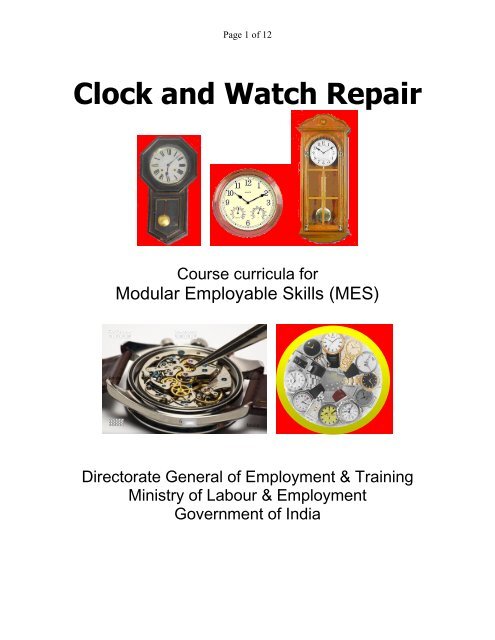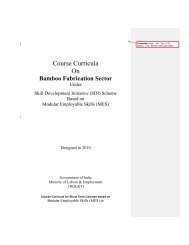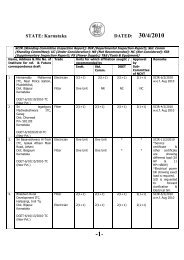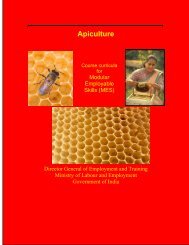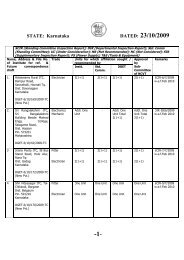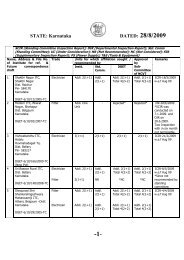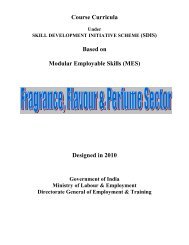Clock and Watch Repair - Directorate General of Employment ...
Clock and Watch Repair - Directorate General of Employment ...
Clock and Watch Repair - Directorate General of Employment ...
You also want an ePaper? Increase the reach of your titles
YUMPU automatically turns print PDFs into web optimized ePapers that Google loves.
Page 1 <strong>of</strong> 12<br />
<strong>Clock</strong> <strong>and</strong> <strong>Watch</strong> <strong>Repair</strong><br />
Course curricula for<br />
Modular Employable Skills (MES)<br />
<strong>Directorate</strong> <strong>General</strong> <strong>of</strong> <strong>Employment</strong> & Training<br />
Ministry <strong>of</strong> Labour & <strong>Employment</strong><br />
Government <strong>of</strong> India
Page 2 <strong>of</strong> 12<br />
1 - Skill Development based on Modular Employable Skills (MES)<br />
1. a Background<br />
Numbers <strong>of</strong> forums have emphasized the need for the skill development, especially for<br />
the less educated, poor <strong>and</strong> out <strong>of</strong> school youth. The skill level <strong>and</strong> educational<br />
attainment <strong>of</strong> the work force determines the productivity, income levels as well as the<br />
adaptability <strong>of</strong> the working class in changing environment. Large percentage <strong>of</strong><br />
population in India is living below poverty line, the main reason being the lower<br />
percentage <strong>of</strong> skilled persons in the workforce.<br />
The skill development at present is taking place mostly in the informal way, i.e. persons<br />
acquire skill at the work-place when they help their parents, relatives <strong>and</strong> employers etc.<br />
Such persons do not have a formal certificate <strong>and</strong> thus earn lower wages <strong>and</strong> are<br />
exploited by employers. They have come through informal system due to socio-economic<br />
circumstances <strong>of</strong> the family <strong>and</strong> the compulsions <strong>of</strong> earning a livelihood rather than<br />
attending a formal course. While their productivity is low, their contribution to the<br />
national GDP cannot be ignored. If the country can create a system <strong>of</strong> certification which<br />
not only recognizes their skills but also provides education <strong>and</strong> training in a mode that<br />
suits their economic compulsions, it will not only benefit the workforce to earn a decent<br />
living but also contribute to the national economy by better productivity <strong>of</strong> this<br />
workforce.<br />
Another related problem is the large number <strong>of</strong> students drop outs (About 63% <strong>of</strong> the<br />
school students drop out at different stages before reaching Class-X).<br />
The third problem is that the industries are facing shortage <strong>of</strong> skilled people to operate<br />
the machines <strong>and</strong> produce the materials, <strong>and</strong> the skills available are not adequate<br />
considering the changing requirement <strong>of</strong> the technology.<br />
1. b. Frame work for Skill Development based on ‘Modular Employable Skills<br />
(MES)’<br />
Very few opportunities for skill development are available for the above referred groups<br />
(out <strong>of</strong> school youth <strong>and</strong> existing workers especially in the informal sector). Most <strong>of</strong> the<br />
existing Skill Development programmes are long term in nature. Poor <strong>and</strong> less educated<br />
persons cannot afford long term training programme due to higher entry qualifications,<br />
opportunity cost etc. Therefore, new frames work for Skill Development for the Informal<br />
Sector has been evolved by the DGET to address to the above mentioned problems. The<br />
key features <strong>of</strong> the new frame work for skill development are:<br />
Dem<strong>and</strong> driven short term training courses based on modular employable skills<br />
decided in consultation with Industry.<br />
Flexible delivery mechanism (part time, weekends, full time)
Page 3 <strong>of</strong> 12<br />
Different levels <strong>of</strong> programme (Foundation level as well as skill up gradation) to<br />
meet dem<strong>and</strong>s <strong>of</strong> various target groups.<br />
Central Government will facilitate <strong>and</strong> promote training while Vocational<br />
Training (VT) Providers under the Government <strong>and</strong> Private Sector will provide<br />
training<br />
Optimum utilization <strong>of</strong> existing infrastructure to make training cost effective.<br />
Testing <strong>of</strong> skills <strong>of</strong> trainees by independent assessing bodies who would not be<br />
involved in conduct <strong>of</strong> the training programme, to ensure that it is done<br />
impartially.<br />
Testing <strong>and</strong> certification <strong>of</strong> prior learning (skills <strong>of</strong> persons acquired informally)<br />
The Short Term courses would be based on ‗Modular Employable Skills (MES)‘.<br />
The concept for the MES is:<br />
Identification <strong>of</strong> ‗minimum skills set‘ which is sufficient to get an employment in<br />
the labour market.<br />
It allows skills up-gradation, multiskilling, multi entry <strong>and</strong> exit, vertical mobility<br />
<strong>and</strong> life long learning opportunities in a flexible manner.<br />
It also allows recognition <strong>of</strong> prior learning (certification <strong>of</strong> skills acquired<br />
informally) effectively.<br />
The modules in a Sector when grouped together could lead to a qualification<br />
equivalent to National Trade Certificate or higher.<br />
Courses could be available from level 1 to level 4 in different vocations<br />
depending upon the need <strong>of</strong> the employer organizations.<br />
MES would benefit different target groups like :<br />
Workers seeking certification <strong>of</strong> their skills acquired informally<br />
workers seeking skill upgradation<br />
early school drop-outs <strong>and</strong> unemployed<br />
previously child labour <strong>and</strong> their family<br />
1. c. Age <strong>of</strong> participants<br />
The minimum age limit for persons to take part in the scheme is 14 years but there is no<br />
upper age limit.<br />
1. d. Curriculum Development Process<br />
Following procedure is used for developing course curricula<br />
Identification <strong>of</strong> Employable Skills set in a Sector based on division <strong>of</strong> work in<br />
the labour market.<br />
Development <strong>of</strong> training modules corresponding to skills set identified so as to<br />
provide training for specific <strong>and</strong> fit for purpose<br />
Organization <strong>of</strong> modules in to a Course Matrix indicating vertical <strong>and</strong> horizontal<br />
mobility. The course matrix depicts pictorially relation among various modules,<br />
pre requisites for higher level modules <strong>and</strong> how one can progress from one level<br />
to another.
Page 4 <strong>of</strong> 12<br />
Development <strong>of</strong> detailed curriculum <strong>and</strong> vetting by a trade committee <strong>and</strong> by the<br />
NCVT (Close involvement <strong>of</strong> Employers Organizations, State Governments,<br />
experts, vocational training providers <strong>and</strong> other stake holders is ensured at each<br />
stages).<br />
1. e. Development <strong>of</strong> Core Competencies<br />
Possession <strong>of</strong> proper attitudes is one <strong>of</strong> the most important attribute <strong>of</strong> a competent<br />
person. Without proper attitudes, the performance <strong>of</strong> a person gets adversely affected.<br />
Hence, systematic efforts will be made to develop attitudes during the training<br />
programme.<br />
The trainees deal with men, materials <strong>and</strong> machines. They h<strong>and</strong>le sophisticated tools <strong>and</strong><br />
instruments. Positive attitudes have to be developed in the trainees by properly guiding<br />
them <strong>and</strong> setting up examples <strong>of</strong> good attitudes by demonstrated behaviours <strong>and</strong> by the<br />
environment provided during training.<br />
Some important core competencies to be developed are:<br />
1. Safety consciousness <strong>and</strong> safe working practices<br />
2. Care <strong>of</strong> equipment <strong>and</strong> tools<br />
3. Punctuality, discipline <strong>and</strong> honesty<br />
4. Concern for quality<br />
5. Respect for rules <strong>and</strong> regulations<br />
6. Concern for health <strong>and</strong> hygiene<br />
7. Cordial relationship <strong>and</strong> Cooperation with co-workers <strong>and</strong> team work<br />
8. Positive attitude <strong>and</strong> behaviour<br />
9. Responsibility <strong>and</strong> accountability<br />
10. Learn continuously<br />
11. Communication skills<br />
12. Concern for environment <strong>and</strong> waste disposal<br />
Following competencies should also be developed during level-II <strong>and</strong> higher courses:<br />
1. Ability for planning, organizing <strong>and</strong> coordinating<br />
2. Creative thinking, problem solving <strong>and</strong> decision making<br />
3. Leadership<br />
4. Ability to bear stress<br />
5. Negotiation<br />
1. f. 6. Duration <strong>of</strong> the Programme<br />
Time taken to gain the qualification will vary according to the pathway taken <strong>and</strong> will be<br />
kept very flexible for persons with different backgrounds <strong>and</strong> experience. Duration has<br />
been prescribed in hours in the curriculum <strong>of</strong> individual module, which are based on the<br />
content <strong>and</strong> requirements <strong>of</strong> a MES Module. However, some persons may take more time
Page 5 <strong>of</strong> 12<br />
than the prescribed time. They should be provided reasonable time to complete the<br />
course.<br />
1. g. Pathways to acquire Qualification:<br />
Access to the qualification could be through:<br />
• An approved training programme;<br />
Or<br />
• A combination <strong>of</strong> an approved training programme plus recognition <strong>of</strong> prior<br />
learning including credit transfer;<br />
Or<br />
• The recognition <strong>of</strong> prior learning that provides evidence <strong>of</strong> the achievement <strong>of</strong> the<br />
competencies for the qualification.<br />
1. h. Methodology<br />
The training methods to be used should be appropriate to the development <strong>of</strong><br />
competencies. The focus <strong>of</strong> the programme is on ―Performing‖ <strong>and</strong> not on ―Knowing‖.<br />
Lecturing will be restricted to the minimum necessary <strong>and</strong> emphasis to be given for<br />
‗H<strong>and</strong>s on training‘.<br />
The training methods will be individual centered to make each person a competent one.<br />
Opportunities for individual work will be provided. The learning process will be<br />
continuously monitored <strong>and</strong> feedback will be provided on individual basis.<br />
Demonstrations using different models, audio visual aids <strong>and</strong> equipment will be used<br />
intensively.<br />
1. i. Instructional Media Packages<br />
In order to maintain quality <strong>of</strong> training uniformly all over the country, Instructional<br />
Media Packages (IMPs) will be developed by the National Instructional Media Institute<br />
(NIMI), Chennai.<br />
1. j. Assessment<br />
DGE<strong>and</strong>T will appoint assessing bodies to assess the competencies <strong>of</strong> the trained<br />
persons. The assessing body will be an independent agency, which will not be involved in<br />
conducting the training programme. This, in turn, will ensure quality <strong>of</strong> training <strong>and</strong><br />
credibility <strong>of</strong> the scheme. Keeping in view the target <strong>of</strong> providing training/testing <strong>of</strong> one<br />
million persons through out the country <strong>and</strong> to avoid monopoly, more than one assessing<br />
bodies will be appointed for a Sector or an area.<br />
1. k. Certificate
Page 6 <strong>of</strong> 12<br />
Successful persons will be awarded certificates issued by National Council for<br />
Vocational Training (NCVT).<br />
1. l. MES courses approved by NCVT<br />
The NCVT released a list <strong>of</strong> 340 approved courses on 15 th September 2008, i.e. on the<br />
Engineers day (128 th birth day <strong>of</strong> Sir. M. Visweswariah). The courses were allotted 6<br />
digit alpha numerical codes with the following formula<br />
From Left side:<br />
1 st , 2 nd <strong>and</strong> 3 rd digits –Sector Codes (Alpha Codes)<br />
4 th digit – Level Code (1 for level 1, 2 for level 2, 3 for level 3 <strong>and</strong> so on. As the level<br />
increases, the position in the industry also increases)<br />
5 th <strong>and</strong> 6 th digits – Course serial number (separate series for courses at same level with in<br />
each 2. Sector)<br />
1.m <strong>Watch</strong> <strong>Repair</strong> sector<br />
Importance <strong>of</strong> time <strong>and</strong> aligning the activities with time has been felt by one <strong>and</strong> all.<br />
<strong>Clock</strong> <strong>and</strong> <strong>Watch</strong> have become an indispensable parts <strong>of</strong> present day human life, may be<br />
male or female, youngster or an elderly one. Some people do not remove their watch<br />
even when they are sleeping. <strong>Watch</strong> is a tiny machine having number <strong>of</strong> parts in it. It is<br />
supposed to work always along with the time; no rest can be given to a watch. But, due to<br />
various reasons, the watches do stop functioning. As the watch contains number <strong>of</strong> small<br />
parts, only a highly skilled person with very good vision power <strong>and</strong> high finger dexterity<br />
can repair the watches. Compared to earlier models <strong>of</strong> clocks <strong>and</strong> watches, the present<br />
models are highly reliable, still sometimes we need them to be attended <strong>and</strong> serviced.<br />
Although number <strong>of</strong> skills <strong>and</strong> sectors are identified <strong>and</strong> approved by NCVT, the <strong>Clock</strong><br />
<strong>and</strong> <strong>Watch</strong> <strong>Repair</strong> sector has not been covered. It was therefore decided to form a<br />
Sectoral Skill Panel to identify the skills in <strong>Clock</strong> <strong>and</strong> <strong>Watch</strong> <strong>Repair</strong> Sector. The panel<br />
was headed by Mr. S. J. Amalan, Director, Apex Hi-Tech Institute, Bangalore <strong>and</strong><br />
Regional Director D.G.E.T, Ministry <strong>of</strong> Labour <strong>and</strong> <strong>Employment</strong>, Karnataka, Andhra<br />
Pradesh <strong>and</strong> Orissa. The committee identified various skills in this sector.
Page 7 <strong>of</strong> 12<br />
LEVEL – 1<br />
1. Module name Basic <strong>Clock</strong> <strong>and</strong> <strong>Watch</strong> <strong>Repair</strong><br />
2. Sector <strong>Clock</strong> <strong>and</strong> <strong>Watch</strong> <strong>Repair</strong><br />
3. Code CWR - 101<br />
4. Entry Qualification Minimum 5 th Std, 14 Years <strong>of</strong> Age<br />
5. Terminal competency Successful c<strong>and</strong>idate would be able to carry<br />
out minor repairs <strong>of</strong> <strong>Clock</strong> <strong>and</strong> <strong>Watch</strong>.<br />
6. Duration 180 Hours<br />
7. Course content<br />
Practical Competencies<br />
Practice Health <strong>and</strong> safety—Select,<br />
use, maintain <strong>and</strong> store –tools,<br />
equipments <strong>and</strong> clothing safety<br />
Practices 5S technique<br />
Identify / Familiarize with the tools<br />
<strong>and</strong> equipments<br />
Identify components <strong>of</strong> clock <strong>and</strong><br />
watch from Assembly, drawings<br />
<strong>and</strong> diagrams<br />
Washing <strong>and</strong> Cleaning <strong>of</strong> parts<br />
<strong>Repair</strong> or replace <strong>of</strong> parts<br />
Check Train Wheel ,Escapement ,<br />
Dial train , H<strong>and</strong> setting<br />
mechanism, train wheel bridge,<br />
Clean Para shock upper <strong>and</strong> lower<br />
Clean pivot <strong>and</strong> bearings<br />
Lubricants<br />
Adjust balance <strong>and</strong> regulator<br />
Change water pro<strong>of</strong> washer<br />
Underpinning Knowledge [Theory]<br />
<strong>General</strong> health <strong>and</strong> Safety<br />
precautions to be observed in work<br />
shop.<br />
Over view on 5S technique [Sort,<br />
Set in order, Shine/ Sweep,<br />
St<strong>and</strong>ardize <strong>and</strong> Sustain ] –<br />
advantages in implementation <strong>of</strong> 5S<br />
Working principle <strong>of</strong> clock <strong>and</strong><br />
watch mechanism<br />
Procedure for dismantling,<br />
assembling,<br />
Types <strong>of</strong> lubrication<br />
Function <strong>of</strong> balance <strong>and</strong> adjustment<br />
Brief introduction on main 6<br />
division<br />
<strong>General</strong> defects<br />
Balance wheel <strong>and</strong> caliber NO <strong>and</strong><br />
size Procedure for repairing<br />
8. Tools <strong>and</strong> equipments needed for training<br />
1.Multipurpose watch case opener CONSUMABLES ;<br />
2.Ultrasonic cleaning machine<br />
Moebius Synt –A lube<br />
3.<strong>Watch</strong> timing machine<br />
Moebius Synt –V lube<br />
4.Demagnetiser<br />
B M-125 grease<br />
5.Case opener –box <strong>and</strong> nap type<br />
Moebius grease with molybdenum<br />
6.Plier for h<strong>and</strong>s removing<br />
Fine chromic oxide [green rouge ]<br />
7.Canon tightening<br />
Fine ferric oxide [red rouge ]<br />
8.movement holder [gents <strong>and</strong> ladies] Locltlte<br />
9.Escapement trying tool<br />
Cemendine<br />
10.Pinvice<br />
Shellac<br />
11.Rivetting stake<br />
Benzene for cleaning purpose<br />
12.Eye glass<br />
13.Screw driver [1 to 10 Set ]<br />
14. Tweezers A A
15.Hair spring tweezers [Straight <strong>and</strong> bend<br />
type]<br />
16.Brass tweezers<br />
17.St<strong>and</strong> type oilier<br />
18.Dial cleaning brush<br />
19.<strong>Watch</strong> maker brush<br />
20.Side cutting nipper<br />
21.Flat cutting nipper<br />
22. Scraper<br />
23.Reamer<br />
24.Collet tuning tool<br />
25.Files<br />
26.Oil stone<br />
27. Grinding stone<br />
28. Benzene cup<br />
29. Dear skin stick<br />
30. Peg wood stick<br />
31. Finger stalls<br />
32. Siliconised cloth<br />
33. Wooden punch<br />
34. Acrylic punch<br />
35. H<strong>and</strong> punch<br />
36. Screw driver for general work<br />
Page 8 <strong>of</strong> 12
Page 9 <strong>of</strong> 12<br />
LEVEL – 1<br />
1. Module Basic <strong>Clock</strong> <strong>Repair</strong>er Analog <strong>and</strong> Digital<br />
2. Sector <strong>Clock</strong> <strong>and</strong> <strong>Watch</strong> <strong>Repair</strong><br />
3. Code CWR - 102<br />
4. Entry Qualification Minimum 5 th Std, 14 Years <strong>of</strong> Age<br />
5. Terminal competency Successful c<strong>and</strong>idate would be able to carry<br />
out minor repairs <strong>of</strong> <strong>Clock</strong><br />
6. Duration 180 Hours<br />
7. Course content<br />
Practical Competencies<br />
Practice Health <strong>and</strong> safety—Select,<br />
use, maintain <strong>and</strong> store –tools,<br />
equipments <strong>and</strong> clothing safety<br />
Practices 5S technique<br />
Identify / Familiarize with the tools<br />
<strong>and</strong> equipments<br />
Identify components <strong>Clock</strong> <strong>and</strong><br />
watch from Assembly, drawings<br />
<strong>and</strong> diagrams<br />
Washing <strong>and</strong> Cleaning <strong>of</strong> parts<br />
<strong>Repair</strong> or replace <strong>of</strong> parts<br />
Salient feature <strong>of</strong> Q A W<br />
Block diagram <strong>of</strong> Q A W<br />
Power source<br />
Oscillating <strong>and</strong> timing system<br />
Motion Transfer<br />
Maintenance<br />
Assembly flow chart<br />
Power cell<br />
E C B<br />
I C <strong>and</strong> L C<br />
Seven segment<br />
L E D<br />
Step motor<br />
Rotor<br />
Stator<br />
Underpinning Knowledge [Theory]<br />
<strong>General</strong> health <strong>and</strong> Safety<br />
precautions to be observed in work<br />
shop.<br />
Over view on 5S technique [Sort,<br />
Set in order, Shine/ Sweep,<br />
St<strong>and</strong>ardize <strong>and</strong> Sustain ] –<br />
advantages in implementation <strong>of</strong> 5S<br />
Working principle <strong>of</strong> QAW<br />
Procedure for dismantling,<br />
assembling,<br />
Types <strong>of</strong> lubrication<br />
Types <strong>of</strong> power cell<br />
Gear train<br />
Function E C B <strong>and</strong> I C<br />
Function <strong>of</strong> L E D<br />
Function <strong>of</strong> rotor <strong>and</strong> stator<br />
Brief introduction on main 6<br />
division<br />
<strong>General</strong> defects<br />
8. Tools <strong>and</strong> equipments needed for training<br />
1.Multipurpose watch case opener CONSUMABLES ;<br />
2.Ultrasonic cleaning machine<br />
Moebius Synt –A lube<br />
3.<strong>Watch</strong> timing machine<br />
Moebius Synt –V lube<br />
4.Demagnetiser<br />
B M-125 grease<br />
5.Case opener –box <strong>and</strong> nap type<br />
Moebius grease with molybdenum<br />
6.Plier for h<strong>and</strong>s removing<br />
Fine chromic oxide [green rouge ]
Page 10 <strong>of</strong> 12<br />
7.Canon tightening<br />
8.movement holder [gents <strong>and</strong> ladies]<br />
9.Escapement trying tool<br />
10.Pinvice<br />
11.Rivetting stake<br />
12.Eye glass<br />
13.Screw driver [1 to 10 Set ]<br />
14. Tweezers A A<br />
15.Hair spring tweezers [Straight <strong>and</strong> bend<br />
type]<br />
16.Brass tweezers<br />
17.St<strong>and</strong> type oilier<br />
18.Dial cleaning brush<br />
19.<strong>Watch</strong> maker brush<br />
20.Side cutting nipper<br />
21.Flat cutting nipper<br />
22. Scraper<br />
23.Reamer<br />
24.Collet tuning tool<br />
25.Files<br />
26.Oil stone<br />
27. Grinding stone<br />
28. Benzene cup<br />
29. Dear skin stick<br />
30. Peg wood stick<br />
31. Finger stalls<br />
32. Siliconised cloth<br />
33. Wooden punch<br />
34. Acrylic punch<br />
35. H<strong>and</strong> punch<br />
36. Screw driver for general work<br />
Fine ferric oxide [red rouge ]<br />
Locltlte<br />
Cemendine<br />
Shellac<br />
Benzene for cleaning purpose
Page 11 <strong>of</strong> 12<br />
LEVEL - 2<br />
1. Module name Automatic <strong>Watch</strong> <strong>Repair</strong>er<br />
2. Sector <strong>Clock</strong> <strong>and</strong> <strong>Watch</strong> <strong>Repair</strong><br />
3. Code CWR - 203<br />
4. Entry Qualification Minimum 5 th Std + CWR 102, 14 Years <strong>of</strong><br />
Age<br />
5. Terminal competency Successful c<strong>and</strong>idate would be able to carry<br />
out minor repairs <strong>of</strong> Automatic watch<br />
6. Duration 280 hours<br />
7. Course content<br />
Practical Competencies<br />
Practice Health <strong>and</strong> safety—Select,<br />
use, maintain <strong>and</strong> store –tools,<br />
equipments <strong>and</strong> clothing safety<br />
Practices 5S technique<br />
Identify / Familiarize with the tools<br />
<strong>and</strong> equipments<br />
Identify components <strong>Clock</strong> <strong>and</strong><br />
watch from Assembly, drawings<br />
<strong>and</strong> diagrams<br />
Washing <strong>and</strong> Cleaning <strong>of</strong> parts<br />
<strong>Repair</strong> or replace <strong>of</strong> parts<br />
Check Train Wheel ,Escapement ,<br />
Dial train , H<strong>and</strong> setting<br />
mechanism, train wheel bridge,<br />
Clean Para shock upper <strong>and</strong> lower<br />
Clean upper <strong>and</strong> lower jewel<br />
Lubricants<br />
Adjust balance <strong>and</strong> regulator<br />
Principle <strong>of</strong> automatic watch<br />
Construction <strong>of</strong> automatic watch<br />
Automatic mechanism working<br />
Day <strong>and</strong> Date mechanism<br />
Uni <strong>and</strong> Bi directional auto winding<br />
Slipping main spring<br />
Underpinning Knowledge [Theory]<br />
<strong>General</strong> health <strong>and</strong> Safety<br />
precautions to be observed in work<br />
shop.<br />
Over view on 5S technique [Sort,<br />
Set in order, Shine/ Sweep,<br />
St<strong>and</strong>ardize <strong>and</strong> Sustain ] –<br />
advantages in implementation <strong>of</strong> 5S<br />
Working principle <strong>of</strong> clock <strong>and</strong><br />
watch mechanism<br />
Procedure for dismantling,<br />
assembling,<br />
Types <strong>of</strong> lubrication<br />
Function <strong>of</strong> balance <strong>and</strong> adjustment<br />
Brief introduction on main 6<br />
division<br />
<strong>General</strong> defects<br />
Balance wheel <strong>and</strong> caliber NO <strong>and</strong><br />
size<br />
Procedure for repairing<br />
Time adjusting<br />
How mechanism works<br />
Oscillating weight<br />
Jumper <strong>and</strong> jumper spring<br />
Date driving wheel<br />
Date driving pinion<br />
Intermediate wheel<br />
Uni <strong>and</strong> Bi directional mechanism<br />
Characteristics <strong>of</strong> main spring
Page 12 <strong>of</strong> 12<br />
1. n. The members <strong>of</strong> the Sectoral Skill Panel for <strong>Clock</strong> <strong>and</strong> <strong>Watch</strong> <strong>Repair</strong> Sector<br />
Mr. S. J. Amalan<br />
Chairman<br />
Mr. L. Nagarajamurthy<br />
Advisor<br />
Mr. B. Purushothama<br />
R.H.Ramakrishnaiah<br />
B.E(Mech)<br />
M.Raju<br />
E.L.Mallanagowda :<br />
Naveen Kumar H.<br />
T.N.Srinivasaiah( DMM)<br />
Director, Apex Hi-Tech<br />
Institute, Bangalore <strong>and</strong><br />
Regional Director D.G.E.T,<br />
Ministry <strong>of</strong> Labour <strong>and</strong><br />
<strong>Employment</strong>, Karnataka,<br />
Andhra Pradesh <strong>and</strong> Orissa.<br />
Former Director <strong>of</strong><br />
Vocational Education,<br />
Government <strong>of</strong> Karnataka<br />
Consultant – QMS <strong>and</strong><br />
Textiles<br />
B-17, Jayanthi Apartments,<br />
13 th cross, 4 th Main,<br />
Malleswaram, Bangalore<br />
560003<br />
Sree Gayatri Auto<br />
Service Station.<br />
Near Banashankari<br />
Kunigal Road. Tumukur<br />
<strong>Watch</strong> Mechanic<br />
SANGAMA<br />
5th main.8thcross<br />
S.S.Puram, Tumukur<br />
Diploma E & C Senior<br />
Officer,<br />
Innovedge,<br />
Titan watch industries<br />
limited,<br />
Tower A Golden Enclave,<br />
Old Airport Road, Bangalore<br />
Executive,<br />
Innovedge,<br />
Titan watch industries<br />
limited,<br />
Tower A Golden Enclave,<br />
Old Airport Road, Bangalore<br />
HMT.WFIV Ex. Dy.<br />
Manager, M.C. Colony S.S<br />
Purum. 16/a, l. cross,<br />
Tumukur<br />
sjamalan@yahoo.co.in<br />
080-23378335<br />
+(91) 0 9880361079<br />
nagarajamurthyl@gmail.com<br />
+(91) 0 9448633189<br />
purushothama1949@yahoo.co.<br />
in<br />
+(91) 0 9448864028<br />
080-23461512<br />
9449643733<br />
rhramakrishna@gmail.com<br />
9980648455<br />
mallanagowda@yahoo.co.in<br />
nkumar@gmail.com<br />
naveenkumarh@titan.com.in<br />
9242357746


